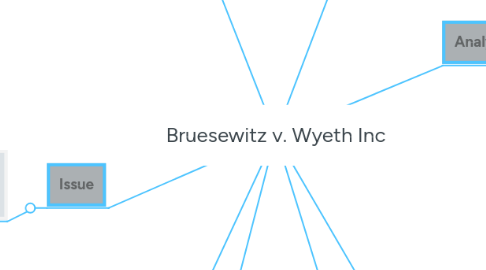
1. Facts
1.1. Parties
1.1.1. Wyeth, Inc. (the drug company who made the vaccine)
1.1.2. Russell Bruesewitz (on behalf of his daughter Hannah)
1.2. What Happened
1.2.1. Russell Bruesewitz filed a petition for compensation after his daughter fell ill
1.2.1.1. Just prior to the petition, Hannah's condition (seizure) was removed the list of illness that can be petitioned for damages.
1.2.1.1.1. Within 3 years, Wyeth removed the vaccine from the market
1.2.2. Federal Judge dismissed the petition
1.2.2.1. further appeal send the case to the Supreme Court
1.2.2.2. Appeals Court upheld the federal judge's decision
1.2.2.3. Supreme Court upheld the decision that the petition should not be heard
1.2.2.3.1. Supreme Court ruled that the a special vaccine court was satisfactory to hear petitions to seek damages against vaccine makers
1.2.2.3.2. NCVIA is satisfactory to resolve petition for damages
1.3. Procedural History
1.3.1. Family petitions for damages
1.3.1.1. Federal judge rules against Brusewitz
1.3.1.1.1. National Childhood Vaccine Injury Act protected Wyeth from lawsuits
1.3.1.2. Supreme Court took up the case in 2010
1.3.1.2.1. Majority decision upheld lower courts decision that National Childhood Vaccine Injury Act protected Wyeth from lawsuits
1.3.1.3. Appeals court supports judge
1.3.2. Claimed drug company failed to develop a safe vaccine and was accountable for injuries caused by the vaccine's defective design
2. Issue
2.1. The key question is whether Bruesewitz (or any plaintiff) has the right to petition for damages to a drug company via a lawsuit
2.1.1. Rule: The 1986 Congressionally enacted NCVIA established a no fault compensation program
2.1.1.1. Wanted faster resolution
2.1.1.2. Designed to provide greater ease than the tort system
2.1.1.3. Need to balance a destabilized vaccine market
2.1.1.3.1. Parents had growing fears of harm to children who are vaccinated
2.1.1.3.2. Drug makers fears preventing their inclusion into the market
2.1.1.3.3. Greater good in consideration
2.1.2. Shalala v. Whitecotton suit led to the NCVIA
2.1.2.1. Dependent on a Vaccine Injury Table
2.1.2.1.1. Source of concern as the injuries on the table are removed based on some subjective criteria
3. Rule of law
3.1. Legal Principles
3.1.1. Plaintiff must show that the injury suffered was outside the realm of the protections provided by the National Childhood Vaccine Injury Act
3.1.2. Plaintiff must prove that illness/injury suffered from a vaccine that is not on the Vaccine Injury Table can be tried in the courts
3.2. Legal Precedence
3.2.1. The 1986 Congressionally enacted NCVIA
3.2.1.1. Established a no fault compensation program
3.2.1.2. Established compensation fund
3.2.1.3. Victims can't petition drug makers for damages in court
4. Analysis/Application
4.1. Brusewitz argues that injury and illness suffered by his daughter was caused by a Wyeth Inc Vaccine and should be able to sue for damages
4.1.1. Reaction (seizure) caused by vaccine was dropped from list of compensatory injury just prior to suit
4.1.1.1. Calls into question how to seek damages for injury suffered not on list
4.1.1.1.1. Court determines that lawsuits of this circumstance will not be heard
4.2. Wyeth Inc argued that the petition was unlawful and should be dismissed
4.2.1. Claim was a compensatory court had jurisdiction
4.2.2. Further claim that they were protected from suit based on 1986 Congressionally enacted NCVIA
4.2.2.1. Lower court agreed with Wyeth and dismissed case
4.2.2.2. Appeals court agreed with lower court decision
4.2.2.3. Supreme court upheld lower courts decision
4.2.2.3.1. NCVIA is lawful
4.2.2.3.2. VICP provides adequate protection for victims who suffer from design defects
4.2.2.3.3. Drug makers need protection to avoid leaving the marketplace and hurting public good
5. Conclusion
5.1. Plaintiffs can't sue drug makers for damages caused by their products
5.1.1. Plaintiffs are entitled to seek compensation for such injury or death by filing a timely claim in the U.S. Court of Federal Claims, which holds special jurisdiction over such cases.
5.2. The NCVIA forum must be used for resolution
5.2.1. The NCVIA's "no-fault" compensation program preempts design-defect claims against vaccine manufacturers brought by plaintiffs seeking damages for injury or death caused by vaccine side effects.
5.3. Supreme Court upheld lower courts and Congressionally enacted law
6. Impact
6.1. The most profound impact was upholding the validity of the NCVIA
6.1.1. Protection to Vaccine makers gives them latitude to bring drugs to market and prevents their leaving the market due to risk/liability
6.1.2. Gives victims (or parents of minor victims) a place to get compensation
6.1.2.1. Also prevents most complainants from receiving compensation
6.1.2.2. Most claims dismissed
6.2. Also created the National Vaccine Injury Compensation Program
6.2.1. 16,000 petitions to this body since its inception
6.2.2. Damages petitions don't go through courts, but rather the NCVIA
7. Importance
7.1. A business professional would care for several reasons
7.1.1. Drug Makers
7.1.1.1. There is protection for the venture of developing vaccines and other drugs for public good
7.1.1.1.1. Mitigator for unusually high level of risk
7.1.1.1.2. Prevents public forum for addressing concerns the might undermine drug makers
7.1.1.1.3. Prevents drug makers from leaving the market
7.1.1.1.4. Ease of mobility
7.1.2. Users of products
7.1.2.1. Risk is associated with use of vaccines
7.1.2.1.1. Users must be aware of venue to petition for relief
7.1.2.1.2. Vaccine Injury Table should be referenced if you feel risk is in play by giving your children the vaccine
8. Influence
8.1. Practice 1: Plaintiffs can only seek compensation via the U.S. Court of Federal Claims.
8.1.1. The 1986 Congressional enacted NCVIA is valid
8.2. Practice 2: The Vaccine Injury Table determines what illness/damage can be considered for damages
8.2.1. Department of Health and Human Services determines the explanation of the illness, disability, injury or condition covered, and the expected time period for first symptom or manifestation of onset or of significant aggravation after vaccine administration
8.2.1.1. Critical for recipients of vaccines to understand this given the Supreme Court ruling that remedy for these injuries will not be considered in court.
8.2.1.2. Also critical to recognize what is NOT on this list.
